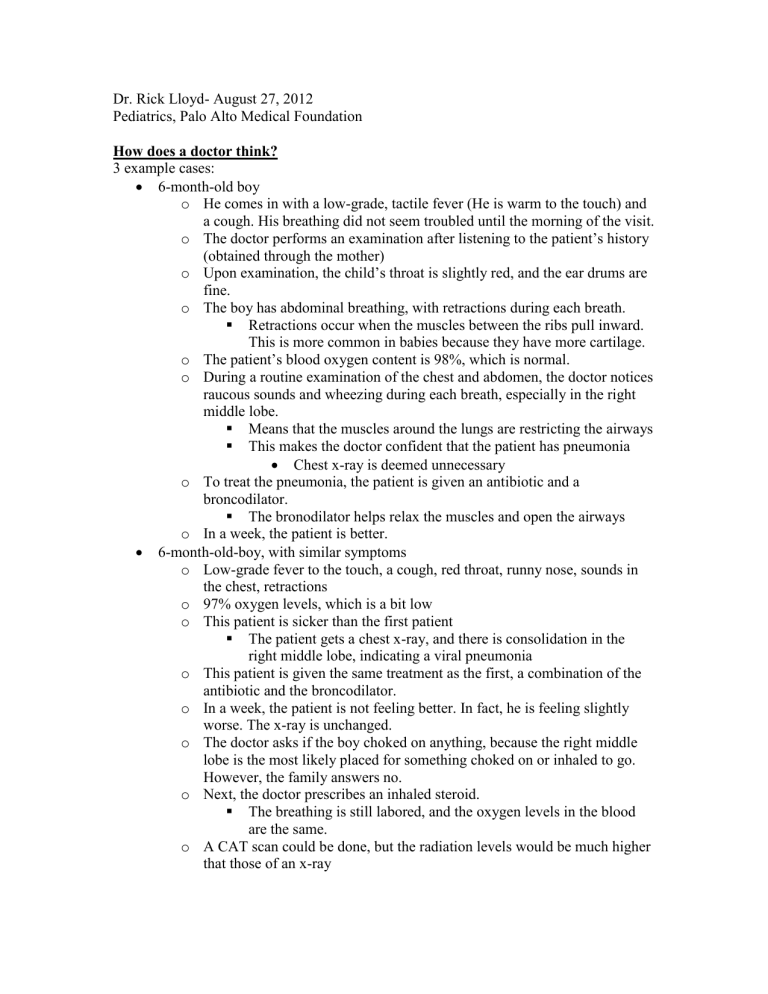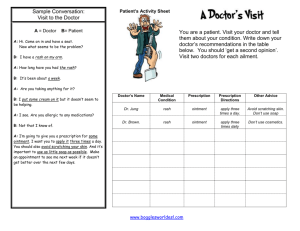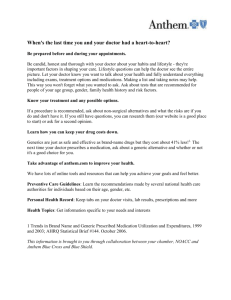Dr. Rick Lloyd- August 27, 2012 Pediatrics, Palo Alto Medical

Dr. Rick Lloyd- August 27, 2012
Pediatrics, Palo Alto Medical Foundation
How does a doctor think?
3 example cases:
6-month-old boy o He comes in with a low-grade, tactile fever (He is warm to the touch) and a cough. His breathing did not seem troubled until the morning of the visit. o The doctor performs an examination after listening to the patient’s history
(obtained through the mother) o Upon examination, the child’s throat is slightly red, and the ear drums are fine. o The boy has abdominal breathing, with retractions during each breath.
Retractions occur when the muscles between the ribs pull inward.
This is more common in babies because they have more cartilage. o The patient’s blood oxygen content is 98%, which is normal. o During a routine examination of the chest and abdomen, the doctor notices raucous sounds and wheezing during each breath, especially in the right middle lobe.
Means that the muscles around the lungs are restricting the airways
This makes the doctor confident that the patient has pneumonia
Chest x-ray is deemed unnecessary o To treat the pneumonia, the patient is given an antibiotic and a broncodilator.
The bronodilator helps relax the muscles and open the airways o In a week, the patient is better.
6-month-old-boy, with similar symptoms o Low-grade fever to the touch, a cough, red throat, runny nose, sounds in the chest, retractions o 97% oxygen levels, which is a bit low o This patient is sicker than the first patient
The patient gets a chest x-ray, and there is consolidation in the right middle lobe, indicating a viral pneumonia o This patient is given the same treatment as the first, a combination of the antibiotic and the broncodilator. o In a week, the patient is not feeling better. In fact, he is feeling slightly worse. The x-ray is unchanged. o The doctor asks if the boy choked on anything, because the right middle lobe is the most likely placed for something choked on or inhaled to go.
However, the family answers no. o Next, the doctor prescribes an inhaled steroid.
The breathing is still labored, and the oxygen levels in the blood are the same. o A CAT scan could be done, but the radiation levels would be much higher that those of an x-ray
Radiation is not cumulative, but the more a person receives, the more likely it is to affect them o Another possibility is cystic fibrosis
A test is done (by measuring the sodium content in the patient’s sweat) and the results come back negative o Three other possibilities:
Right Middle Low syndrome
An abnormally placed artery in that area that is compressing the bronchus
A lymph node is obstructing the bronchus o A bronchoscopy is done
The stem of an apple is discovered in the bronchus
14 year-old girl o Comes in with a swollen right knee
Has been swelling on an off for a couple of months
She is a catcher in softball, so she assumed that the swelling was the result of a softball-related injury
However, there was no specific injury o She has not traveled out of the country, doesn’t report any stiffness in the morning, and the doctor doesn’t hear a murmur in her heart o After listening to the patient’s history and listening to the family talk, the doctor can ask more directed questions:
Do you have a family history of arthritis?
The mother had arthritis
Had the family been on hikes?
Yes
Did she have a tick bite?
No, not that they knew of
Did she have a rash?
No o People developing lupus arthritis get a distinctive, butterfly-shaped rash o People with Lyme disease develop a target-shaped rash on their backs o Lyme disease was still a possibility because only half or people with the disease recall having been bitten by a tick or having a rash
A blood test was done for Lyme disease, but the results were negative
However, Lyme disease tests are not very accurate o The antigen protein tested for is often present in the body under normal circumstances
Blood count was normal, but she was slightly anemic o A Sedimentation rate test was done, which is very accurate
The result was 50, which is high
Indicates that the infection was more serious than it appeared
o There was a possibility of pus in the knee
She was tested for septic arthritis, a bacterial infection of the knee
Test was negative o Juvenile rheumatoid arthritis was a possibility
The rheumatologist looked for oral or nasal ulcers, which she didn’t have
She was put on the same medication her mother used for arthritis o This past Saturday, she came in with a rash in her mouth
The doctor and rheumatologist agreed that the knee problem was something more serious, having to do with the rash in her mouth o A culture of the rash, a sedimentation rate, and blood count were done
Sedimentation rate and blood count were normal
Why should you be a doctor? o Being a doctor is hard work, but rewarding. o The reason for becoming a doctor is the desire to be of service and to make a difference in other people’s lives.







